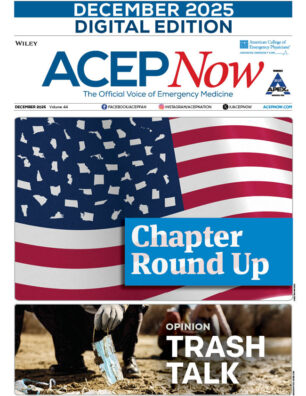
Case
A 22-year-old pitcher gets struck in the chest by a baseball coming off the bat while at spring training camp. He goes down on the mound and is suspected to have commotio cordis.1 The athletic trainers immediately start CPR for the witnessed cardiac arrest. Paramedics quickly arrive and wonder if they should stay on the scene or transport the patient with resuscitation still in progress.
Explore This Issue
ACEP Now: Vol 42 – No 02 – February 2023Clinical Question
What is the best in out-of-hospital cardiac arrest (OHCA)? Remain and gain or load and go?
Background
It is unclear from the published medical literature which practice is superior in adult patients with refractory OHCAs. Some countries have a physician-led model, like in Europe, and provide more care in the field. In contrast, the North American model has traditionally been “load and go.”
In the U.S., there is a fair bit of variability. Some emergency medical service (EMS) agencies transport almost all patients regardless of return of spontaneous circulation (ROSC), while others rarely transport if ROSC is not achieved. Which approach provides the best patient-oriented outcome has not been determined.
Reference: Grunau, et al. Association of intra-arrest transport vs continued on-scene resuscitation with survival to hospital discharge among patients with out-of-hospital cardiac arrest. JAMA. 2020;324(11):1058–1067.
- Population: Adults 18 years and older with non-traumatic OHCA (defined as persons found apneic and without a pulse who underwent either external defibrillation [bystanders or EMS] or chest compressions).
- Exclusions: Aged less than 18 years, do-not-resuscitate order being discovered, transport prior to cardiac arrest, missing data to classify as intra-arrest or to classify the primary outcome, missing variables required for propensity score analysis.
- Intervention: Intra-arrest transport prior to any episode of ROSC defined as palpable pulse for any duration.
- Comparison: Continued on-scene resuscitation.
- Outcome:
- Primary Outcome: Survival to hospital discharge.
- Secondary Outcomes: Survival with favorable neurologic outcome (defined as a modified Rankin scale [mRS] score of less than three).
- Type of Study: Multi-center (192 EMS agencies) observational study.
Authors’ Conclusions
Among patients experiencing out-of-hospital cardiac arrest, intra-arrest transport to hospital compared with continued on-scene resuscitation was associated with lower probability of survival to hospital discharge. Study findings are limited by potential confounding due to observational design.
Results
The included population consisted of 43,969 patients. The median age was 67 years, two-thirds were male, and half were bystander- or EMS-witnessed. Of these OHCAs, 22 percent had an initial shockable rhythm and one-quarter underwent intra-arrest transport.
Key Result
In adults with OHCAs, survival was more likely with continuous, on-scene resuscitation compared to intra-arrest transport.
- Primary Outcome: Survival to hospital discharge 12.6 percent on-scene vs 3.8 percent with transport.
- Difference -8.8 percent (95 percent CI -8.3 percent to -9.3 percent).
- Secondary Outcomes: See Table 1.
- EBM Commentary:
- Association is Not Causation: This was an observational study design, which means we cannot conclude causation, but rather only associations. Propensity score matching was done to mitigate some of the biases from non-randomized trials. While these statistical methods can help balance observed baseline covariates, they cannot get to the same level as a randomized control trial.2
- Prognosis Bias: Bias in research can be defined as something that could systematically move the results away from the best point estimate of an observed effect size. Prognosis bias has seven major domains: study participation, attrition, selection of candidate predictors, outcome definition, confounding factors, analysis, and interpretation of results.3 The authors felt that their study could suffer from attrition bias. Adult patients with OHCA and unfavorable phenotypes may have had resuscitation terminated. This means they would not have the opportunity to achieve ROSC. There was a large difference in the termination of resuscitation (0.2 percent of intra-arrest transport compared to 56.7 percent for the on-scene resuscitation).
- Safety of First Responders: While patient care is the primary concern, we must also be concerned about the wellbeing of the EMS paramedics. Providing CPR in the back of a moving ambulance raises concerns about safety. There are data published in Annals of Emergency Medicine reporting an increased odds ratio of crashing with the use of lights and sirens.4 This could lead to increased risk to paramedics who are providing resuscitation during transportation.
SGEM Bottom Line
Low-quality evidence suggests “remain and gain” is associated with better survival to hospital discharge in adults patients with OHCAs compared to “load and go.”
Case Resolution
The paramedic crew stay on scene providing high-quality CPR, identify a shockable rhythm, defibrillate the pitcher, achieve ROSC, and transport the patient to the hospital.
Remember to be skeptical of anything you learn, even if you heard it on the Skeptics’ Guide to Emergency Medicine.

Dr. Milne (@TheSGEM) is chief of emergency medicine and chief of staff at South Huron Hospital, Ontario, Canada. He is on the Best Evidence in Emergency Medicine faculty and is creator of the knowledge translation project the Skeptics’ Guide to Emergency Medicine (www.TheSGEM.com).
References
- Maron BJ, Estes NA 3rd. Commotio cordis. N Engl J Med. 2010;362(10):917-27.
- Austin PC. An Introduction to propensity score methods for reducing the effects of confounding in observational studies. Multivariate Behav Res. 2011;46(3):399-424.
- D’Amico G, Malizia G, D’Amico M. Prognosis research and risk of bias. Intern Emerg Med. 2016;11(2):251-60.
- Watanabe BL, Patterson GS, Kempema JM, et al. Is use of warning lights and sirens associated with increased risk of ambulance crashes? a contemporary analysis using national EMS information system (nemsis) data. Ann Emerg Med. 2019;74(1):101-109.
Article Inspiration
This month’s article was inspired by Buffalo Bills safety Damar Hamlin’s cardiac arrest sustained on the football field.
Pages: 1 2 3 | Multi-Page






No Responses to “Out-Of-Hospital Cardiac Arrest: Remain and Gain, or Load and Go?”